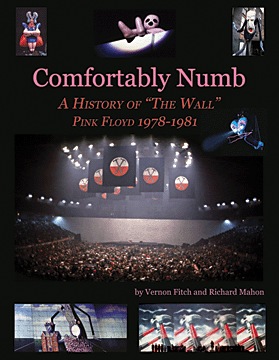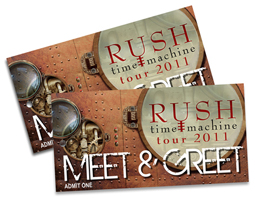






http://www.brain-damage.co.uk/books/comfortably-numb-a-history-of-the-wall-vernon-fitch-and-richard-2.html
It is rare that a Pink Floyd book appears that instantly gains a position amongst the most essential titles, recommended as a cornerstone of the (somewhat bulging) Floydian book shelves.
Historian Vernon Fitch's two previous titles - PF Press Reports and Encyclopedia - are amongst those titles. Certainly, we refer to these all the time for information and fact checking.
The good news is that Vernon, along with his co-author Richard Mahon, has done it again. 'Comfortably Numb - A History of “The Wall”, 1978-1981', published on July 25th, is a beautifully illustrated yet richly detailed hardback tome that concerns itself solely with that album.
Research for the book has been ongoing for the last ten years, and part of this has involved approaching all those involved in the album and live show - from the band themselves, to designers, to sound engineers. Apart from rich detail, many of these people have also contributed their own, previously unseen pictures, and these are included within the pages. In total there are over 400 pictures in the book.
Frustrated with the views and demands of various mainstream publishers, Vernon decided to set up his own company, PFA Publishing Inc., and this book is the first from PFA. Normally, avoiding established publishing houses spells trouble and takes the publication into the realms of blurry, badly printed and poorly presented - but not in this case. Glossy pages throughout, colours are rich, strong, and there are no colour separation issues.
With contributions from Marc Brickman, Brian Christian, Bob Ezrin, Stan Farber, Mark Fisher, David Gilmour, James Guthrie, Rick Hart, Andy Jackson, Jon Joyce, Michael McCarty, Nick Mason, Patrice Quef, Gerald Scarfe, Rick Stratton, Phil Taylor, Toni Tennille, Trevor Veitch, Roger Waters, and numerous others, the book should be the definitive look at the album. We took a long hard look at it to see how it turned out.
Kicking off with a whistle-stop (but peppered with key detail) history of the band, the pressures on the band are clearly shown with all signs pointing at the genesis of The Wall.
Indeed, the authors point out that even at the time of DSOTM, Waters started jotting ideas down in a notebook that read "Wall of dreams", "nobody can hurt me behind my Wall", and "optimism... pessimism... fear... building The Wall... co-operation breeds progress, competition breeds decay". For many, such early references to The Wall will come as a huge surprise, and is typical of the detail uncovered in this book.
The pre-Wall history of the band culminates with Roger working on the original demo, which the authors give a track-by-track breakdown of. Fascinating stuff and dramatically different to the finished product.
With Roger's Wall demo selected as the next band piece (in preference to the Pros & Cons demo he also presented them) work started on the recording sessions. These are described in loving detail, giving a real "fly on the wall" look at how the sessions were recorded at London's Britannia Row, the Super Bear and Miraval studios in France, and New York's 30th Street and Columbia Recording Studios. Coupled with incredible pictures of the studios, the equipment, and the band and crew at work and play, it really is like being there.
There are also many interesting passages which detail who does what on the recording, and some great anecdotes relating to some of the more unusual sound effects... many of which seem to rope in Phil Taylor!
On a more serious note, the stresses and strains during the recording sessions are drawn in sharp relief, going into much greater detail - on the musical conflicts - than has been seen before.
Once the coverage of the recording sessions is concluded, the book moves to the visual elements of the project. Gerald Scarfe talks of how the concepts developed, and early sketches are shown of the Punch & Judy idea and various other early characterizations (as seen in more depth in Scarfe's own book, Drawing Blood, an absorbing retrospective on his career - reviewed on BD).
A track-by-track look at the album follows, with full detail of who did what, with what instruments, and what each song means in the context of the story. Some fascinating insights and revelations here, coupled with promotional artwork and record covers from different countries.
Almost half the book is devoted to the live performance of what was to prove an astonishing, and ground-breaking piece of rock theatre.
Possibly the more interesting part of this is the period from initial concepts to the finished article. With the combination of unusual staging (not least the wall-building and safe demolition requirement), complex projections, spanning the width of the arena, inflatables and more, work began well over a year before the first dates were played.
There are some fascinating unused designs by Mark Fisher displayed, showing ideas which never came to fruition, and the progression in the design of the fully functioning wall and bricks clearly illustrates the problems and considerations in implementing an idea which on paper, is relatively straightforward!
The authors also cover the production rehearsals in detail, before launching into the description of the show itself, song by song. Until the concerts finally get their official release on DVD (hinted at various points - most recently in 2004 - as possibly coming out) this will be the only way for many fans to get a good impression of how the shows unfolded.
To complete the narrative on the live concerts, a show-by-show description is given, with photos, ticket stubs and other memorabilia sitting alongside transcripts of on-stage introductions and chat. If nothing else (and for some it will be heading into too much detail!), these will enable easy identification of those bootlegs you've got lurking in your collection!
Matters conclude with a look at the official audio and video recordings made, how different performances were picked for the "Is There Anybody Out There" release in March 2000, and a look at the possible future for The Wall.
To tidy everything off, the appendices include a worldwide official and bootleg release discography, and a full rundown of the band's equipment used on the album and on the road.
"Comfortably Numb" contains a staggering level of detail - absolutely staggering... with no stone (or should I say, brick?) unturned; the book has every detail you could potentially wish for, and plenty more besides.
With a donation from sales of each book going to Amnesty International, and the incredible content within, this book is truly an essential item for any Floyd fan. Let's hope that Vernon and Richard carry on with their research and bring us detailed looks at other albums in the band's back catalogue.
The book is limited to 5,000 copies, each hand numbered and signed by the authors, and costs $39.95 plus shipping. More information on the book, with example pages, can be found at www.PFApublishing.com where you can also place your orders for this incredible book. It is not available in bookshops or elsewhere online.
































